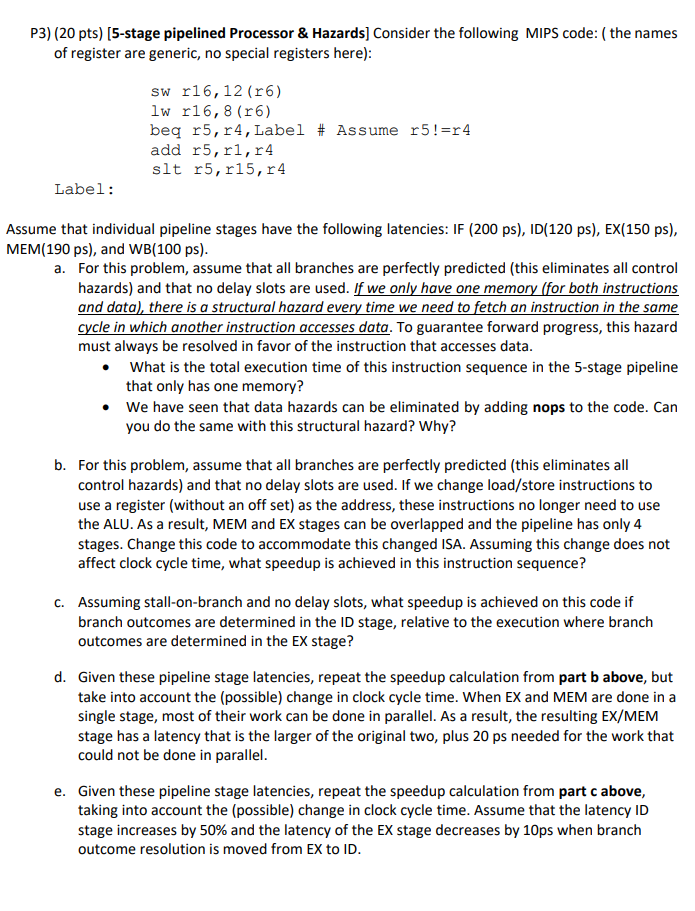
P3) (20 pts) [5-stage pipelined Processor & Hazards] Consider the following MIPS code: (the names of register are generic, no special registers here): sw r16, 12 (r6) lw r16,8 (16) beg r5, r4, Label # Assume r5!=r4 add r5, r1, r4 slt r5,r15,r4 Label: Assume that individual pipeline stages have the following latencies: IF (200 ps), ID(120 ps), EX(150 ps), MEM(190 ps), and WB(100 ps). a. For this problem, assume that all branches are perfectly predicted (this eliminates all control hazards) and that no delay slots are used. If we only have one memory (for both instructions and data), there is a structural hazard every time we need to fetch an instruction in the same cycle in which another instruction accesses data. To guarantee forward progress, this hazard must always be resolved in favor of the instruction that accesses data. What is the total execution time of this instruction sequence in the 5-stage pipeline that only has one memory? We have seen that data hazards can be eliminated by adding nops to the code. Can you do the same with this structural hazard? Why? b. For this problem, assume that all branches are perfectly predicted (this eliminates all control hazards) and that no delay slots are used. If we change load/store instructions to use a register (without an off set) as the address, these instructions no longer need to use the ALU. As a result, MEM and EX stages can be overlapped and the pipeline has only 4 stages. Change this code to accommodate this changed ISA. Assuming this change does not affect clock cycle time, what speedup is achieved in this instruction sequence? C. Assuming stall-on-branch and no delay slots, what speedup is achieved on this code if branch outcomes are determined in the ID stage, relative to the execution where branch outcomes are determined in the EX stage? d. Given these pipeline stage latencies, repeat the speedup calculation from part b above, but take into account the (possible) change in clock cycle time. When EX and MEM are done in a single stage, most of their work can be done in parallel. As a result, the resulting EX/MEM stage has a latency that is the larger of the original two, plus 20 ps needed for the work that could not be done in parallel. e. Given these pipeline stage latencies, repeat the speedup calculation from partc above, taking into account the possible) change in clock cycle time. Assume that the latency ID stage increases by 50% and the latency of the EX stage decreases by 10ps when branch outcome resolution is moved from EX to ID. P3) (20 pts) [5-stage pipelined Processor & Hazards] Consider the following MIPS code: (the names of register are generic, no special registers here): sw r16, 12 (r6) lw r16,8 (16) beg r5, r4, Label # Assume r5!=r4 add r5, r1, r4 slt r5,r15,r4 Label: Assume that individual pipeline stages have the following latencies: IF (200 ps), ID(120 ps), EX(150 ps), MEM(190 ps), and WB(100 ps). a. For this problem, assume that all branches are perfectly predicted (this eliminates all control hazards) and that no delay slots are used. If we only have one memory (for both instructions and data), there is a structural hazard every time we need to fetch an instruction in the same cycle in which another instruction accesses data. To guarantee forward progress, this hazard must always be resolved in favor of the instruction that accesses data. What is the total execution time of this instruction sequence in the 5-stage pipeline that only has one memory? We have seen that data hazards can be eliminated by adding nops to the code. Can you do the same with this structural hazard? Why? b. For this problem, assume that all branches are perfectly predicted (this eliminates all control hazards) and that no delay slots are used. If we change load/store instructions to use a register (without an off set) as the address, these instructions no longer need to use the ALU. As a result, MEM and EX stages can be overlapped and the pipeline has only 4 stages. Change this code to accommodate this changed ISA. Assuming this change does not affect clock cycle time, what speedup is achieved in this instruction sequence? C. Assuming stall-on-branch and no delay slots, what speedup is achieved on this code if branch outcomes are determined in the ID stage, relative to the execution where branch outcomes are determined in the EX stage? d. Given these pipeline stage latencies, repeat the speedup calculation from part b above, but take into account the (possible) change in clock cycle time. When EX and MEM are done in a single stage, most of their work can be done in parallel. As a result, the resulting EX/MEM stage has a latency that is the larger of the original two, plus 20 ps needed for the work that could not be done in parallel. e. Given these pipeline stage latencies, repeat the speedup calculation from partc above, taking into account the possible) change in clock cycle time. Assume that the latency ID stage increases by 50% and the latency of the EX stage decreases by 10ps when branch outcome resolution is moved from EX to ID







